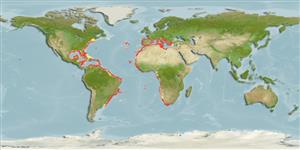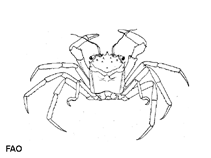Homola barbata (Fabricius, 1793)
Homole crab| Native range | All suitable habitat | Point map | Year 2050 |

|
| This map was computer-generated and has not yet been reviewed. |
| Homola barbata AquaMaps Data sources: GBIF OBIS |
رده بندی / Names اسامي عام | مترادف | CoL | ITIS | WoRMS
Malacostraca | Decapoda | Homolidae
Environment: milieu / climate zone / تغييرات عمق / distribution range بوم شناسي
; تغييرات عمق 10 - 682 m (مرجع 62709). Tropical; 46°N - 38°S, 98°W - 37°E
Distribution كشورها | مناطق سازمان خوار و بار جهاني (FAO) | Ecosystems | ظهور | معرفي
Atlantic Ocean and the Mediterranean: from USA (Massachusetts, and Virginia to south Florida), West Indies, Central America and Brazil (Rio de Janeiro to Rio Grande do Sul) to Western Africa, including Canary and Madeira Islands, to Mediterranean Sea, and northeastern Atlantic from Spain to Portugal. Temperate to tropical.
Length at first maturity / Size / Weight / سن
بلوغ: Lm ? range ? - ? cm Max length : 1.5 cm CW جنس نر / بدون خواص جنسي; (مرجع 93549)
Life cycle and mating behavior بلوغ | تولید مثل | تخم ریزی | Eggs | Fecundity | Larvae
مآخذ اصلی
مراجع | هماهنگ كننده | همكاران
Coelho Filho, P.A. 2004 Análise do macrobentos na plataforma continental externa e bancos oceânicos do nordeste do Brasil no âmbito do programa REVIZEE. Grupo de estudo do Bentos (Oceanografia Biológica), Programa REVIZEE. 81 p. (مرجع 2364)
وضعيت در فهرست قرمز IUCN
(مرجع 130435: Version 2025-1)
وضعيت از نظر سايتس (مرجع 108899)
CMS (مرجع 116361)
خطر برای انسان ها
استفاده انسانی
| FishSource |
ابزارها
اطلاعات بيشتر
منابع اينترنتي
BHL | BOLD Systems | CISTI | DiscoverLife | FAO(Publication : search) | Fishipedia | GenBank (ژنوم, نوکلئوتيد) | GloBI | Gomexsi | Google Books | Google Scholar | Google | PubMed | Tree of Life | Wikipedia (برو, جستجو) | Zoological Record



